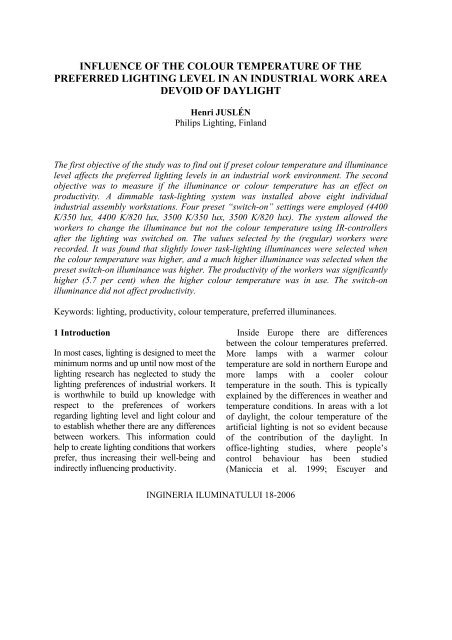This issue is sponsored by the Philips Romania, Lighting Division
This issue is sponsored by the Philips Romania, Lighting Division
This issue is sponsored by the Philips Romania, Lighting Division
Create successful ePaper yourself
Turn your PDF publications into a flip-book with our unique Google optimized e-Paper software.
INFLUENCE OF THE COLOUR TEMPERATURE OF THE<br />
PREFERRED LIGHTING LEVEL IN AN INDUSTRIAL WORK AREA<br />
DEVOID OF DAYLIGHT<br />
Henri JUSLÉN<br />
<strong>Philips</strong> <strong>Lighting</strong>, Finland<br />
The first objective of <strong>the</strong> study was to find out if preset colour temperature and illuminance<br />
level affects <strong>the</strong> preferred lighting levels in an industrial work environment. The second<br />
objective was to measure if <strong>the</strong> illuminance or colour temperature has an effect on<br />
productivity. A dimmable task-lighting system was installed above eight individual<br />
industrial assembly workstations. Four preset “switch-on” settings were employed (4400<br />
K/350 lux, 4400 K/820 lux, 3500 K/350 lux, 3500 K/820 lux). The system allowed <strong>the</strong><br />
workers to change <strong>the</strong> illuminance but not <strong>the</strong> colour temperature using IR-controllers<br />
after <strong>the</strong> lighting was switched on. The values selected <strong>by</strong> <strong>the</strong> (regular) workers were<br />
recorded. It was found that slightly lower task-lighting illuminances were selected when<br />
<strong>the</strong> colour temperature was higher, and a much higher illuminance was selected when <strong>the</strong><br />
preset switch-on illuminance was higher. The productivity of <strong>the</strong> workers was significantly<br />
higher (5.7 per cent) when <strong>the</strong> higher colour temperature was in use. The switch-on<br />
illuminance did not affect productivity.<br />
Keywords: lighting, productivity, colour temperature, preferred illuminances.<br />
1 Introduction<br />
In most cases, lighting <strong>is</strong> designed to meet <strong>the</strong><br />
minimum norms and up until now most of <strong>the</strong><br />
lighting research has neglected to study <strong>the</strong><br />
lighting preferences of industrial workers. It<br />
<strong>is</strong> worthwhile to build up knowledge with<br />
respect to <strong>the</strong> preferences of workers<br />
regarding lighting level and light colour and<br />
to establ<strong>is</strong>h whe<strong>the</strong>r <strong>the</strong>re are any differences<br />
between workers. <strong>Th<strong>is</strong></strong> information could<br />
help to create lighting conditions that workers<br />
prefer, thus increasing <strong>the</strong>ir well-being and<br />
indirectly influencing productivity.<br />
INGINERIA ILUMINATULUI 18-2006<br />
Inside Europe <strong>the</strong>re are differences<br />
between <strong>the</strong> colour temperatures preferred.<br />
More lamps with a warmer colour<br />
temperature are sold in nor<strong>the</strong>rn Europe and<br />
more lamps with a cooler colour<br />
temperature in <strong>the</strong> south. <strong>Th<strong>is</strong></strong> <strong>is</strong> typically<br />
explained <strong>by</strong> <strong>the</strong> differences in wea<strong>the</strong>r and<br />
temperature conditions. In areas with a lot<br />
of daylight, <strong>the</strong> colour temperature of <strong>the</strong><br />
artificial lighting <strong>is</strong> not so evident because<br />
of <strong>the</strong> contribution of <strong>the</strong> daylight. In<br />
office-lighting studies, where people’s<br />
control behaviour has been studied<br />
(Maniccia et al. 1999; Escuyer and
















